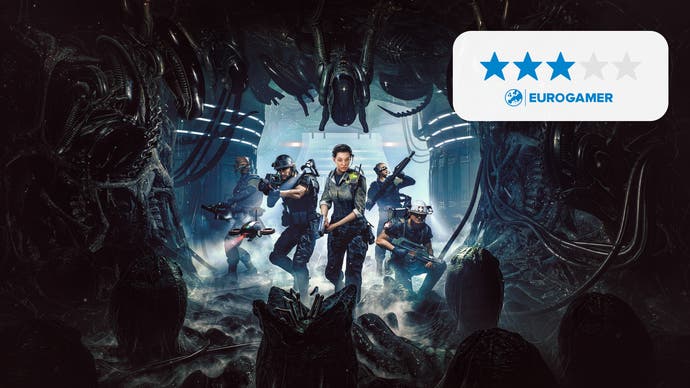Aliens: Dark Descent - more stand-up fight than bug hunt
Hive got a feeling.
The absolute worst thing in Aliens: Dark Descent isn't an alien, but the timeline in the top-right of the screen - or as I like to call it, Satan's Fast Forward Button. In this scrappy but compelling top-down tactics adaptation from Battlefleet Gothic: Armada developer Tindalos Interactive, you lead up to four Colonial Marines around labyrinths of corridors, flaming wreckage and sealed rooms, completing missions of the "activate the generator" variety while fending off - or preferably, avoiding - xenomorphs of all sizes and degrees of canonicity.
Armed with battle rifles, Smart Guns, flame-throwers, grenade launchers and, of course, shotguns for close encounters, your squad can shut down a single vanilla Alien without too much trouble, providing you master certain basic gambits like back-pedalling while shooting xenos to avoid their acid blood. But alerting one Alien alerts the entire hive, triggering a Hunt phase during which other Aliens home in on your position, while also kicking the aforesaid timeline into motion.
As the timeline advances, it increases the number and aggressiveness of the Aliens roaming each environment. The dots on your motion tracker move faster, switch direction more frequently, and make more spiteful use of the terrain, diving into tunnels to respawn behind you or lurking in vents next to rooms that harbour objectives. The timeline also gradually introduces beefier grades of extra-terrestrial, like the ground-pounding Crusher and the oddly team-spirited Praetorian, which hurries around rallying the other monsters like a D&D hero trying to Gather Their Party.
These points of escalation appear as coloured segments and icons, each creeping insidiously towards the middle of the bar as the Hunt goes on. Above all, you'll want to watch out for exclamation marks. These initiate an Onslaught, giving you 20 seconds to prep before spawning a horde at the far end of the map. It's the siege scene from the movie, but you won't always have the luxury of four walls and an obvious direction of attack (not that those walls helped Hicks and co in the end). For every Onslaught I've triggered while lurking in a tidy medbay with a single door I can weld shut and furniture to cower behind, I've triggered another while exploring some open space with multiple points of approach, such as a factory floor or, gulp, the depths of the hive itself.
Surviving Onslaughts comes down to three things: find a surface to set your back to, place defences such as turrets and mines to cover all angles, and set up arcs of suppression fire - Dark Descent's equivalent of overwatch - to slow the rush and bog the Aliens down in the killzone. It rarely goes according to plan, not least because you only have a limited, slowly replenishing supply of Command Points to perform special actions. Stack too many suppression orders, and you won't have the points to lay down a firewall with your incinerator, or pick off a Praetorian with your sniper rifle.
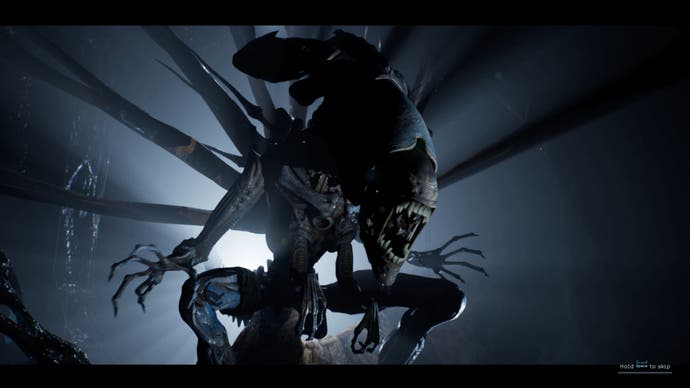
Your weapon of last resort is Retribution, an overdrive bar filled by taking damage, which heals and buffs your marines while immediately refilling your command points. Given a solid sense of priorities - should you spend those bonus points on a shotgun blast to stop a Drone abducting your Medic, or call in a dropship bombardment to flatten the Facehuggers massing behind? - it'll power you out of a corner like Ripley hijacking the APC. Still, the safer winning strategy is to avoid the need for Retribution in the first place, sneaking between the dots on your radar and using doors and coverspots to break sightlines. You will always need to face the horde eventually, care of a story objective (the game courteously flashes up an "are you ready to die?" prompt whenever you meddle with something especially plot-sensitive). The trick is not to take too much punishment before you have to.
Phew! I've plunged right into the steaming guts of this one. Let's back up a little to avoid the acid. As the above hopefully illustrates, Dark Descent is a terrific show of how to translate a beloved action film's key beats and dramatic rhythms into recurring game systems without sabotaging their magic, though it stumbles here and there. It unfolds on Lethe, a newly overrun colony planet that is visually identical to the film's LV-426, though later environments also evoke the original Alien's Nostromo starship and the prison planet of Alien 3.
Playing as corpo bureaucrat Maeko Hayes and locally-born marine sergeant Jonas Harper, you take charge of a crashlanded cruiser, the Otago, which is basically an Aliens version of the base in XCOM, with animated tabs for healing and levelling up units, researching or buying equipment, and outfitting squads for expeditions. Your overall goal is to survive and escape Lethe, which is subject to an automated satellite quarantine, but you'll also delve into the torrid pasts of both lead characters and investigate the mystery of the xenomorph emergence.


Launching marine expeditions consumes a day, and every few days the planet's overall infestation level increases, making the maps more hazardous. This stokes pressure to finish each map's to-do list briskly and progress the story before the water gets too hot. Unlike in XCOM, the game asks you to reload a save when you lose a whole squad. But if you play badly, you might have to limp back to your APC and waste a day before completing all the primary objectives.
The strategy aspect is a touch underwhelming. "XCOM + license" is a formula that's been done to death, and unlike, say, Warhammer 40,000 - Daemonhunters: Chaos Gate, Aliens: Dark Descent doesn't introduce any memorable mechanics or stylistic flourishes at the campaign level. It's as spare and utilitarian as the boxy grey architecture of the Otago itself. But I think this is deliberate, inasmuch as the emphasis seems to be slightly more on story than strategy - the campaign feels designed to be finished on the first attempt. On standard difficulty, at least, it's harder to paint yourself into a corner than in XCOM. The game even "cheats" to avoid no-win scenarios: at one stage, the Otago came under attack while all my troops were laid up in the infirmary, but as luck would have it, four lost marines stumbled out of the wasteland to save the day.
If the strategy stuff feels pedestrian, the action on the ground picks up the slack, not least because it understands the dramatic impact of taking control away from the player. Here's something I should have made clear up the page there, instead of wittering about timelines: you don't manoeuvre units individually, nor do you do any shooting yourself. Rather, you guide your squad as one, laying waypoints and selecting actions from a hotbar, with the game deciding which unit performs them.
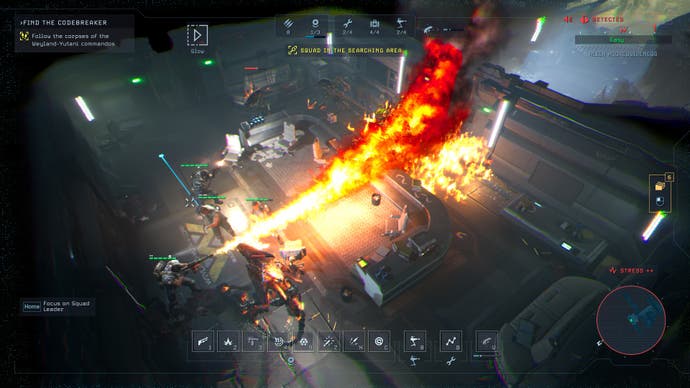
The AI does a good job of organising the troops, letting you respond quickly to threats without needing to micromanage, though you'll rely heavily on the slow-motion menu selection - given that the Aliens are, in some cases, actually swifter than the bullets you fire at them, I'm not sure Dark Descent would be playable without it. But the quiet genius of the whole-squad approach is also that it's unwieldy in a way that is true to the film.
The golden rule of any horror movie is don't split up, right? In Dark Descent, you can spread out your squad by, say, having one unit deploy some mines near a door while another collects a datapad. Should an Alien pop up while they're doing so, you'll be at a thrilling disadvantage, because you can't manoeuvre each unit around the threat. That touch of tactical mushiness also affects stealth: if your team are dispersed - perhaps because one marine is carrying a wounded comrade and so, unable to run - there's more risk of the trailing edge of your formation catching a xenomorph's attention, and again, you can't wrangle that single exposed trooper back into cover.
Blend those touches of engaging imprecision with the rising tension and crescendos cultivated by the timeline/aggression mechanics, and you've got one of the better Aliens adaptations, and perhaps the best Aliens-inspired tactics game, not that the field is crowded. Sadly, a few things hold Dark Descent back. One is that it could really do with a wider variety of dialogue lines for your marines. After 20 hours with the game, I fear the phrase "come on squad!" has become a permanent feature of my internal soundscape. I could have done with a larger range of music, too: the combat theme is a polished reprise of the film's hellish orchestral score, but my goodness does it get repetitive.

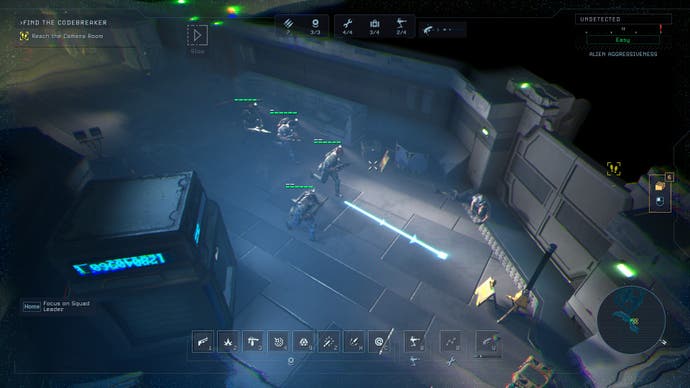
A bigger issue is the game's cartoonish representation of the mental state of your marines, which tries to systematise the squad chemistry from the movie, but feels undercooked. As in Darkest Dungeon, your marines accrue stress in combat and sprout traits such as Bully which affect their and the squad's performance, obliging you to pack them off to the therapist between missions. After reading about this in previews, I was all primed for some Hudson or Vasquez-style soap opera - people going berserk and running into egg chambers, or losing their nerve and refusing to budge.
In practice, it's all handled in an abstract, RPG fashion, which you notice at the level of menus rather than personalities. Certain character states reduce accuracy, for example, or slow the regeneration of command points. Managing these debuffs is a challenge - amongst other things, you can seal off rooms to save the game and buy your squad a breather, resetting their stress levels. But it's not what I was hoping for. I'm curious to know whether Tindalos experimented with more dramatic "sanity effects" before settling on the final version.
The sorest spot of all, though, is that Dark Descent has a bit of a Third Faction problem (beware spoilers from this point). The campaign is only just getting into its stride when it abruptly whisks the Aliens to one side like some kind of warm-up band, and grandly introduces a cult of human xeno-worshippers, evolved from rebellious colonists who've set up shop in the wastes. I have fought a lot of cultists in video games, from Fallout to Mad Max, and Dark Descent's contribution doesn't even break my top 100. Some gallop into your bullets flailing hammers and shovels, others take cover and shoot at you like it's 2003 and bro, have you played Kill Switch?
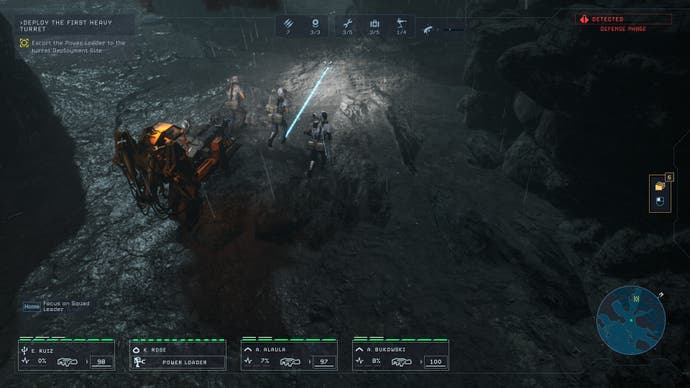
The human foes are an intriguingly macabre addition to the story, in reminding you that, prior to the xenomorph outbreak, one of the principle functions of the Colonial Marines within the Aliens universe was to stomp unruly workers on behalf of Weyland-Yutani. They're enforcers before they are bughunters, operating hand-in-glove with one of sci-fi's best-known villainous corporations. The game's cutscenes and found documents dig into this, but not compellingly enough to justify the tedium of skirmishes with the cult, who thankfully aren't a feature of every map. I'd much rather Tindalos had spent the associated dev resources fleshing out the xenomorphs even further.
Still, these are blemishes you forget when you're watching an exclamation mark crawl along the timeline, even as you try to lay the smackdown on an Alien Queen. Some critic I can't remember once described Hamlet as a text made up entirely of quotations. You can say the same of Aliens - every line and scene, every musical sting or prop is a cherished pop culture artefact, and I imagine that, when adapting the movie, it's easy to feel like you're just bolting together the pieces. It takes real insight to reconstruct those pieces in a way that feels both faithful and transformative, and while Aliens: Dark Descent isn't always as graceful or inspired as it could be, it just about sticks the landing. State of the badass art? Near as damn it.
